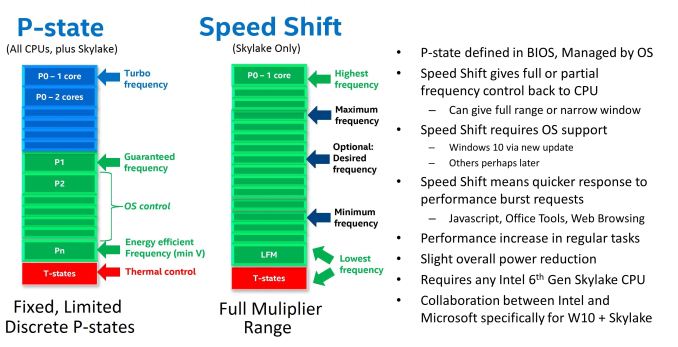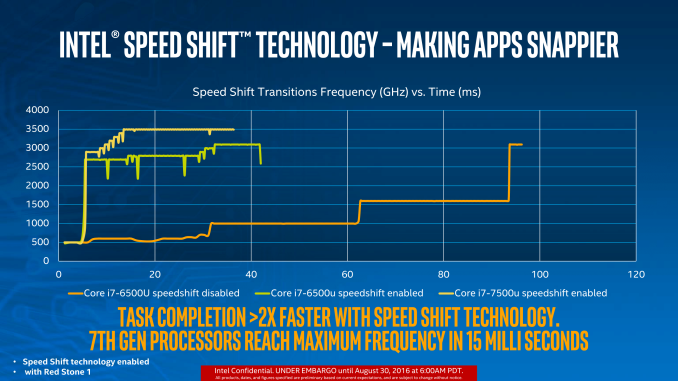The Intel Core i3-7350K (60W) Review: Almost a Core i7-2600K
by Ian Cutress on February 3, 2017 8:00 AM EST7th Generation New Features
One of the big questions regarding the launch of Intel’s 7th Generation of CPUs was around what extra features the new platform brings, especially if there isn’t any clock-for-clock performance improvement. As with our other Kaby Lake reviews, here we explain the main two: Speed Shift v2 and Optane Memory support.
Speed Shift v2
For the Intel’s 6th Generation of processors, Skylake, they introduced Speed Shift (v1). This was a feature that, at a high level, gave control of the voltage/frequency curve from the operating system to the processor. Using a series of internal metrics, such as instruction analysis and frequency, the CPU would automatically adjust the voltage and frequency of the processor as required. This afforded two major benefits: one, with the CPU in control it has access to many more points on the curve compared to the OS which is limited to specific P-states on the processor.
The second benefit is the speed of transition. A processor that can ramp up to a high frequency quickly and then drop down as needed can get through instructions quicker but also save power. Imagine driving a car, and having to wait 60 seconds to change a gear – it’s that sort of analogy.
What Speed Shift v2 does in the Kaby Lake family, compared to v1 in Skylake, is manage those transitions to higher frequency faster. Before Speed Shift, transitions from idle to peak turbo were on the order of 100 milliseconds, and Speed Shift v1 took that to 30 milliseconds (with a good base established within 15). Speed Shift v2 means that peak performance from idle now happens in 10-15 milliseconds total. This means that interactions with the OS, such as touch, or actions that rely on low latency, can occur within a couple of frames on a 60 Hz display.
The benefit of Speed Shift lies a lot in touch devices, which perhaps doesn’t affect the desktop Kaby Lake processors in this review, but also in web interactions. A lot of web work is stop and start, such as scrolling or javascript functions.
There is one caveat however – Speed Shift currently only works in Windows 10. It requires a driver which is automatically in the OS (v2 doesn’t need a new driver, it’s more a hardware update), but this limitation does mean that Linux and macOS do not benefit from it. I would be hard pressed to not imagine that Apple and Intel were not working on a macOS driver, but as yet we have not had confirmation that one exists.
Optane Memory Support
The latest memory technology to hit prime time is Intel and Micron’s 3D XPoint. This is a non-volatile form of data storage that is bit addressable and can be used as DRAM or storage. Despite being at least a decade in the making, and being formally announced in 2014, it is still yet to show up commercially as it is still being developed. Intel plans to create 3D XPoint DRAM that is slightly slower than normal DRAM but both denser (more of it) and non-volatile (keeps the data after power loss, saves power altogether), as well as 3D XPoint Storage that is faster than standard NAND flash, and more configurable. It the scheme of things, we expect the storage based products to hit the market first.
Intel, as far as we can tell, is set to release two main classes of product: Optane DRAM to be pin-compatible with DDR4 and require Optane DRAM enabled processors, and Optane SSDs which should work with any PCIe storage interface. ‘Optane Memory’ however, is something a little different. Based on pre-briefings, Optane Memory is certainly not Optane SSD we were told, but rather a storage cache for mechanical hard-drives. We’ve had this before with NAND flash drives, using Intel’s Rapid Storage Technology, and it seems that Kaby Lake and 200-series chipsets will support a new version of RST for PCIe based storage. But because this is caching drive, such as the 16GB Optane Memory drives in Lenovo’s upcoming notebooks, and not Optane SSD, might lead us to believe that ‘Optane Memory’ drives are not designed to be directly user addressable.
All that being said, Intel has stated that Optane Memory standalone drives should hit the market nearer Q3 for general consumer use, which is more in-line with what we might expect to see with Optane SSDs in the enterprise space.













186 Comments
View All Comments
watzupken - Friday, February 3, 2017 - link
A dual core processor is still a dual core processor even if it is unlocked and offers a high clockspeed. I still feel Kaby Lake is a lazy upgrade over Skylake considering it barely offers anything new. Just take a look at the feature page to get a sense of the "upgrades". With competition coming from ARM and AMD Ryzen, is Intel only capable of a clockspeed war just like they did for Pentium 4?CaedenV - Friday, February 3, 2017 - link
Well, to be fair Kabby Lake isn't for you and I. It is Skylake with very minor improvements mostly aimed at fixing the firmware level sleep and wake issues that manufacturers had (ie, the reason Apple didn't move to Skylake until well after release, and the botched deployment of the Surface Pro 4).Outside of that it is just skylake with a minor clock bumb, slightly better thermals, and more of the chip on 14nm.
Shadowmaster625 - Friday, February 3, 2017 - link
So it will be 2025 before an i3 beats a stock 2600K in all benchmarks? That must mean it will be 2030 before it can beat a 4.8GHz 2600K. That's crazy, considering how badly the Core2Quad compares to even a modern celeron.user_5447 - Friday, February 3, 2017 - link
Page 2: "There is one caveat however – Speed Shift currently only works in Windows 10. It requires a driver which is automatically in the OS (v2 doesn’t need a new driver, it’s more a hardware update), but this limitation does mean that Linux and macOS do not benefit from it."This is incorrect: support for Speed Shift (HW pstates) was commited to Linux kernel back in November of 2014, way before Skylake release.
https://lkml.org/lkml/2014/11/6/628
Hinton - Friday, February 3, 2017 - link
Of the 3 CPU'S Anandtech received to review, this was the only one that was marginally interesting (we didn't need a review to know Kabylake performs equally to Skylake).So of course you spent one month before reviewing it. Good for Anand that he took the money and ran.
fanofanand - Friday, February 3, 2017 - link
You may be unaware, but Ian has been kind of busy lately......Meteor2 - Sunday, February 5, 2017 - link
He has? How so?PCHardwareDude - Friday, February 3, 2017 - link
This would be interesting if the part wasn't so bloody expensive. $120 would be interesting.At this price, you're better off spending a little more and getting an i5 or spending a lot less and getting the G4600, which is also dual core kaby lake with hyperthreading.
AssBall - Friday, February 17, 2017 - link
If you have a GPUnotjamie - Friday, February 3, 2017 - link
At £170 this is the exact price I paid for my 3570k almost 5 years ago. That's what I call progress.